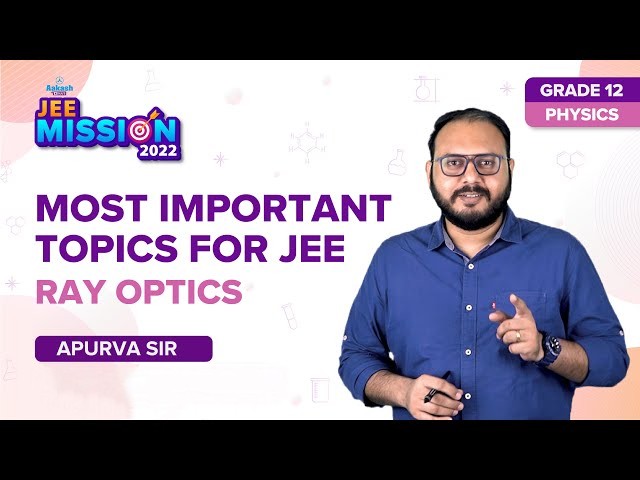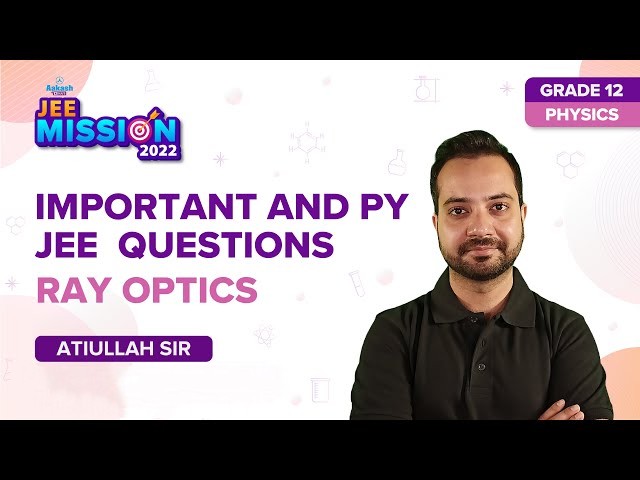In optics, a ray is the idealised geometrical representation of light. Phenomenon such as reflection and refraction of light is explained by considering light as a ray. When a ray of light hits a flat mirror, the light gets reflected from the surface such that the output angle is equal to the input angle. If the surface of the mirror is curved, the calculation is done based on the tangential flat plane. A portion of the light gets refracted, and a portion gets reflected when it hits the interface between two different media.
Question 1)A ball is dropped from a height of 20 m above the surface of the water in a lake. The refractive index of water is 4/3. A fish inside the lake, in the line of fall of the ball, is looking at the ball. At an instant, when the ball is 12.8 m above the water surface, the fish sees the speed of the ball as g = 10m/s2.
(A) 9 m/s
(B) 12 m/s
(C) 16 m/s
(D) 21.33 m/s
Answer: (C) 16 m/s
Solution:

Speed of the ball at 12.8 m
v2 = u2+2as
v2 = 0 + 2(10)(7.2)
v = √2(10)(7.2)
= 12 m/s
Speed of the ball as seen by the fish, v’ = refractive index of water x speed of ball
= μw x V
= (4/3) x 12 = 16 m/s
Question 2) A student performed the experiment of determining the focal length of a concave mirror by the u-v method using an optical bench of length 1.5 m. The focal length of the mirror used is 24 cm. The maximum error in the location of the image can be 0.2 cm. The 5 sets of (u, v) values recorded by the student (in cm) are : (42, 56), (48, 48), (60, 40), (66, 33), (78, 39). The data set(s) that cannot come from the experiment and is (are) incorrectly recorded, is (are) :
(A) (42, 56)
(B) (48, 48)
(C) (66, 33)
(D) (78, 39)
Answer: (C) and (D)
Solution:
Mirror formula, (1/v) + (1/u) = 1/f
Therefore, v = uf/(u – f)
Option A, v = 42 x 24/(42 – 24)
= (42 x 24)/18
= 56 cm
Option B, v =48×24/(48−24)
=48 cm
Option C, v =(66×24)/66−24
=37.7cm
Option D, v =78×24/(78−24)
=34.7cm
Question 3) A biconvex lens of focal length 15 cm is in front of a plane mirror. The distance between the lens and the mirror is 10 cm. A small object is kept at a distance of 30 cm from the lens. The final image is
(A) virtual and at a distance of 16 cm from the mirror
(B) real and at a distance of 16 cm from the mirror
(C) virtual and at a distance of 20 cm from the mirror
(D) real and at a distance of 20 cm from the mirror
Answer: (B) real and at a distance of 16 cm from the mirror
The first image will be formed by the convex lens, the second by the plane mirror and the third again by a convex lens.
Applying the lens formula, (1/v) + (1/u) = 1/f
(1/v) – (1/-30) = 1/15
⇒ v = 30, i.e., it is formed 20 cm behind the plane mirror
The plane mirror will form the image 20 cm in front of it.
For the third image, again applying the lens formula,
(1/v) – (1/10) = 1/15
This gives, v = 6cm
So from the plane mirror, we have a distance of 6+10=16cm.
Question 4) A ray OP of monochromatic light is incident on the face AB of prism ABCD near vertex B at an incident angle of 600 (see figure). If the refractive index of the material of the prism is √3, which of the following is (are) correct?
(A) The ray gets totally internally reflected at face CD
(B) The ray comes out through face AD
(C) The angle between the incident ray and the emergent ray is 900
(D) The angle between the incident ray and the emergent ray is 1200

Answer: (A), (B) and (C)
Solution:

For the surface AB applying Snell’s law,
1 sin 60 = √3 sin r
√3/2 = √3 sin r
r = 300
In quadrilateral BCQP
60 + 135 + θ + 90 = 360
θ = 450
Applying Snell’s law at CD surface to find the critical angle
√3 sin θc = (1) sin 90
θc = sin -1(1/√3)
= sin-1(1/1.732)
= 350
θc < 450 (Therefore, total internal reflection takes place at the face CD)
The ray undergoes total internal reflection and hits the face AD at an angle of 300
At AD surface
√3 sin θc = (1) sin 90
θc = sin -1(1/√3)
= sin-1(1/1.732)
= 350
θc >300 (Therefore, ray comes out through face AD)
Applying Snell’s law face AD
√3 sin 30 = sin α
√3 x (½) = sin α
⇒ α = sin-1 (1.732/2)
= sin -1(0.866)
α = 600 (The ray emerges at 600)
The angle between the incident ray and the emergent ray is 900
Question 5)The focal length of a thin biconvex lens is 20 cm. When an object is moved from a distance of 25 cm in front of it to 50 cm, the magnification of its image changes from m25 to m50 .The ratio
Answer: 6
Solution:
Mirror formula,
(1/v)-(1/u) = 1/f
(u/v)-1=u/f
(u/v) = (u+f)/f
m=v/u=f/ (u+f)
m25/m50 = [20/ (-25+20)]/ [20/ (-50+20)] = 6
Question 6)Image of an object approaching a convex mirror of radius of curvature 20 m along its optical axis is observed to move from (25/3) m to (50/7) in 30 seconds. What is the speed of the object in km per hour?
(a) 3
(b) 4
(c) 5
(d) 6
Answer: (a) 3
Solution:
1/u1 = (3/25) – (1/10)
⇒ u1 = 50 m
1/(+50/7) +(1/-u2) = 1/10
1/u2 = (7/50) – (1/10)
⇒u2= 25 m
speed of object = (u1 -u2) / time = (25/30) ms-1
= (25/30) x (18/5)= 3 kmh-1
Question 7)A large glass slab μ = 5/3 of thickness 8 cm is placed over a point source of light on a plane surface. It is seen that light emerges out of the top surface of the slab from a circular area of radius R cm. What is the value of R?

(a) 6 cm
(b) 7 cm
(c) 8 cm
(d) 9 cm
Answer:(a) 6 cm
Solution:
Snell’s law
sin i/sin r = η1/η2
sin i = R/√R2+82
Therefore, [R/√R2+82]/1 = 1/(5/3) [ Since, sin 900 = 1] [R/√R2+82]2= (3/5)2
⇒[R/√R2+82]2= 9/25
[R2/R2+64]= 9/25(25 – 9)R2 = 576
16R2 = 576
R = 6 cm
Question 8) A light ray travelling in a glass medium is incident on a glass-air interface at an angle of incidence θ. The reflected (R) and transmitted (T) intensities, both as a function of θ, are plotted. The correct sketch is –

Answer: (C)
Solution:
When the light is incident at an angle lesser than the critical angle a small part of the light will be reflected and most parts will be transmitted.
When the light is incident greater than the critical angle, it gets completely reflected (total internal reflection) These characteristics are depicted in option (c).
Question 9) Choose the correct statement.
(A) The speed of light in the meta-material is v= c।nl
(B) The speed of light in the meta-material is v = c/|n|
(C) The speed of light in the meta-material is v = c.
(D) The wavelength of the light in the meta-material λm is given by λm=λair|n| where λair is the wavelength of the light in air.
Answer: (B) The speed of light in the meta-material is v = c/|n|
Solution:
n = c/v
⇒ v = c/n
Question 10)The image of an object, formed by a plano-convex lens at a distance of 8 m behind the lens, is real and is one-third the size of the object. The wavelength of light inside the lens is 2/3 times the wavelength in free space. The radius of the curved surface of the lens is:
(A) 1 m
(B) 2 m
(C) 3 m
(D) 6 m
Answer: (C) 3 m
Solution:
(1/f) = (μ – 1)/R
= (1/v) – (1/u)
μ= λa/ λm
Given, λm = (⅔) λa
⇒ μ= λa/ (⅔) λa
= 3/2 = 1.5
Also, v = u/3
⇒ m = -(v/u) = – u/3u
= -(⅓)
Therefore, u = -24 cm
Substituting all the values in
(μ – 1)/R = (1/v) – (1/u)
(1.5 – 1)/R = (⅛) – (1/-24)
0.5/R = (⅛) + (1/24)
⇒(1/ R) = 2 x (⅙)
⇒ R = 3 m
Also Read:
JEE Main Ray Optics Previous Year Questions with Solutions
Ray Optics – Important Topics

Ray Optics – Important Questions

Comments